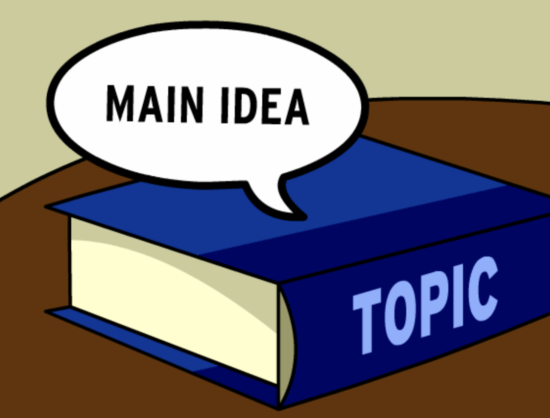Understanding the Main Idea
When you pick up a book, an article, or even a social media post, there’s always a central concept, a core message that ties everything together. This essence is what we call the Main Idea. It’s the golden thread that guides the reader through the narrative, ensuring they grasp the author’s purpose.
What is a Main Idea?
The main idea is like the North Star of a piece of content, guiding both the writer and the reader. It encapsulates the primary focus, the key point that the author wants to convey. Just as a movie trailer gives you a glimpse of the film’s plot, the main idea sets the stage for what to expect in the text.
Importance of Main Ideas
Think of the main idea as the backbone of your content. Without a clear main idea, your writing can feel disjointed, confusing, or aimless, leaving readers scratching their heads. By articulating the main idea concisely, you ensure that your message resonates with your audience, making your content more compelling and memorable.
Strategies for Identifying
Now that we understand the significance of the main idea, let’s delve into some strategies for identifying it effectively.
Reading Comprehension Techniques
One of the fundamental skills in deciphering the main idea is honing your reading comprehension abilities. Train yourself to read actively, engaging with the text rather than passively scanning through it. Highlight key phrases, jot down notes, and ask yourself questions to deepen your understanding.
Active Reading Strategies
Active reading goes beyond mere consumption; it involves interaction. Challenge yourself to summarize each paragraph in your own words. Pay attention to the author’s tone, the recurring themes, and any shifts in perspective. By actively engaging with the text, you’ll uncover nuances that might otherwise go unnoticed.
Analyzing Main Ideas
Once you’ve grasped the basics of identifying the main idea, it’s time to dive deeper into its analysis.
Breaking Down Texts
Many texts, especially longer ones, contain multiple layers of meaning. Break down the content into smaller chunks, analyzing each section for its main idea. This granular approach allows you to dissect complex narratives and extract the core message from each segment.
Identifying Supporting Details
A strong main idea is often accompanied by supporting details that bolster its credibility. Look for evidence, examples, statistics, or anecdotes that reinforce the central concept. These supporting elements not only validate the main idea but also provide context and depth to your interpretation.
Importance of Context
Understanding the context surrounding the podcastnightschool.com/ is crucial for interpreting it accurately.
Contextualizing the Main Idea
Every piece of content exists within a broader context, whether it’s historical, cultural, or societal. Take into account the time period in which the text was written, the author’s background, and the prevailing attitudes of the era. Contextualizing the main idea allows you to appreciate its significance within the larger narrative.
Relating to the Larger Theme
Consider how the main idea connects to the overarching theme of the content. Does it reinforce the central motif, or does it challenge conventional wisdom? By placing the main idea in the context of the broader theme, you gain a deeper understanding of its implications and significance.
Crafting Engaging Content
Now that you’ve mastered the art of identifying and analyzing main ideas, let’s explore how to incorporate them into your own writing.
Writing with Clarity and Precision
When crafting your content, clarity should be your guiding principle. Clearly articulate your main idea from the outset, ensuring that every sentence contributes to its development. Avoid convoluted language or excessive jargon that might obscure your message.
Utilizing Examples and Analogies
Concrete examples and vivid analogies can breathe life into your main idea, making it more relatable and memorable for your audience. Draw parallels to real-life situations, use metaphors to simplify complex concepts, and pepper your writing with illustrative anecdotes. By grounding your main idea in tangible experiences, you foster a deeper connection with your readers.
SEO Optimization
In the digital landscape, visibility is key. Let’s explore how to optimize your content for search engines.
Keyword Research
Before you even begin writing, conduct thorough keyword research to identify the terms and phrases your audience is searching for. Integrate these keywords naturally into your content, including them in headings, subheadings, and body text. However, prioritize relevance and readability over keyword density.
On-Page Optimization
Optimize your content for on-page elements such as meta titles, meta descriptions, and alt tags. These elements provide search engines with valuable context about your content, increasing its likelihood of ranking prominently in search results. Additionally, structure your content using H1, H2, and H3 tags to signal the hierarchy of information to both readers and search engines.
Engaging the Audience
Beyond search engine optimization, it’s essential to engage your audience actively.
Interactive Elements
Incorporate interactive elements such as polls, quizzes, or embedded multimedia to enhance user engagement. Encourage readers to participate actively in the content rather than passively consuming it. Interactive elements not only capture attention but also foster a sense of community and interactivity.
Encouraging Comments and Feedback
Invite readers to share their thoughts, opinions, and questions in the comments section. Respond promptly to comments, fostering a dialogue with your audience and building rapport. By actively engaging with your readers, you cultivate a loyal following and demonstrate your commitment to customer satisfaction.
Conclusion
In conclusion, mastering the art of identifying and analyzing main ideas is a foundational skill for effective communication. By understanding the significance of main ideas, employing strategies for identification and analysis.






